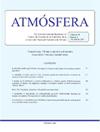A breviary of Earth’s climate changes using Stephan-Boltzmann law
IF 1
4区 地球科学
Q4 METEOROLOGY & ATMOSPHERIC SCIENCES
引用次数: 0
Abstract
Earth’s surface temperature oscillated greatly throughout time. From near congelation during “snowball Earth” 2.9Gya to an ice-free world in the Paleocene-Eocene Thermal maximum 55Mya. These changes have been forced by internal (e.g. changes in the chemical composition of the atmosphere) or external (e.g. changes in solar luminosity) drivers that varied through time. Thus, if we understand how the radiation budget evolved in different times, we can closely calculate past global climate; a fundamental comparison to situate current climate change in the context Earth’s history. Here I present an analytical framework employing a simple energy balance derived from the Stephan-Boltzmann law, that allows for quick comparison between drivers of global temperature and at multiple moments in the history of our planet. My results show that current rates of increase in global temperature are at least four times faster than any previous warming event.使用斯蒂芬-玻尔兹曼定律的地球气候变化简章
地球表面的温度在整个时间内波动很大。从“雪球地球”期间的近凝结2.9Gya到古新世-始新世的无冰世界热最大值55Mya。这些变化是由随时间变化的内部(如大气化学成分的变化)或外部(如太阳光度的变化)驱动因素造成的。因此,如果我们了解辐射预算在不同时期是如何演变的,我们就可以密切计算过去的全球气候;将当前气候变化置于地球历史背景下的基本比较。在这里,我提出了一个分析框架,该框架采用了从Stephan Boltzmann定律导出的简单能量平衡,可以快速比较全球温度的驱动因素和我们星球历史上的多个时刻。我的研究结果表明,目前全球气温的上升速度至少是以往任何一次变暖事件的四倍。
本文章由计算机程序翻译,如有差异,请以英文原文为准。
求助全文
约1分钟内获得全文
求助全文
来源期刊

Atmosfera
地学-气象与大气科学
CiteScore
2.20
自引率
0.00%
发文量
46
审稿时长
6 months
期刊介绍:
ATMÓSFERA seeks contributions on theoretical, basic, empirical and applied research in all the areas of atmospheric sciences, with emphasis on meteorology, climatology, aeronomy, physics, chemistry, and aerobiology. Interdisciplinary contributions are also accepted; especially those related with oceanography, hydrology, climate variability and change, ecology, forestry, glaciology, agriculture, environmental pollution, and other topics related to economy and society as they are affected by atmospheric hazards.
 求助内容:
求助内容: 应助结果提醒方式:
应助结果提醒方式:


